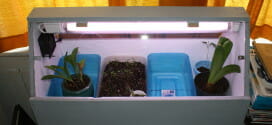For many of us, planting and growing vegetables starts as a hobby and slowly evolves into a time consuming annual event. The garden gets bigger, we experiment with new vegetables, we learn fresh techniques, and when the season ends we can’t wait for the New Year to start again. One way to get the most out of our precious time is to plant perennials.
There are many easy to grow vegetables and herbs that grow back year after year and require very little maintenance. You don’t have to plant seeds under grow lights, harden them off in the spring and transplant them to the garden when the cold has left the ground. Perennials simply come roaring back to life after sleeping all winter and all you have done is cover them with a cozy layer of mulch at the end of the season.
Whether you have an existing vegetables or herb garden or will be starting a new one, plant some perennials and you will enjoy the results for many years to come. Here is a list of basic perennial vegetables and herbs to get started with:
1- Perennial Asparagus
Once planted a good asparagus bed can last for decades. The only real enemy that asparagus has is weeds. Keep your bed weed free, throw a layer of compost on top each year to maintain the health of the soil and you will have a boatloads of tender spears for many years. A word of caution however. Asparagus “crowns” take about three years to fully mature so be patient. It is well worth the wait!

2- Sea Kale
This is a large perennial with bluish green leaves and small white flowers. When the young shoots emerge in the spring, blanch them before eating. The stalks should be blanked as well sand eaten in salads, or baked boiled or braised much like asparagus.

3- Chives Herb
Here is a perennial herb that is easy to grow, hard to kill, and very popular throughout the world.

4- Jerusalem Artichoke
Sometimes referred to as “Sunchokes”, these are tubers that thrive around the world. They can be invasive, so keep an eye on the spreading roots. The edible part of the Jerusalem is their nut flavored roots that when cooked, make a nice alternative to potatoes.

5- Radicchio
This is a leafy type of chicory perennial vegetable made up of red leaves with white veins running throughout. The leaves are common in salads, taken from the heads that are about five inches in diameter. Radicchio is common in Italian cuisine, either grilled or mixed with dishes like risotto.

6- Peppers
While planted as an annual in many home gardens, peppers can be considered as perennials in warmer climates. Even in cooler locations, the plants can be brought inside and cared for over the winter, and returned to the garden in the spring.

7- Perennial Rhubarb
Rhubarb plants can last for hundreds of years. Their huge leaves are poisonous, but the stalks are great for pies, jellies and jams. They thrive in cool weather and the leaves are very attractive in any garden. Large healthy plants can be divided and easily replanted to share with neighbors and friends.

8-Wild Leeks
Also referred to as “Ramps” these plants are quite tender early in the spring and produce edible bulbs in the fall, winter and spring. They are very pungent so use sparingly until you learn how to use appropriately. They are easy to identify in the wild with smooth light green leaves that become purple as they connect with the white bulbs just below the surface of the soil. Great for cooking!

9- Garlic
While not typically referred to as a perennial, if you plant a bed of garlic and leave a few in the ground, they will certainly come back next year if protected with a layer of mulch over the winter. Most home gardeners simply plant garlic bulbs and harvest the entire crop when ready which is why they plant garlic as an annual. Try growing the perennial route and you’ll be reward with fresh garlic every year.

10- Globe Artichoke
These are the true artichokes (members of the thistle family) that are not related to the Jerusalem variety listed above. Like garlic, globes are considered perennials if planted in temperate climates but will do well in cooler areas if brought inside and carefully tended to over the winter.

We should also mention Horseradish, a great idea when starting a vegetable garden. It is easy to grow and a great conversation piece! It is a vegetable, not an herb, and most people have no idea where their horseradish sauce comes from. The plants are highly prolific and very invasive. Its gnarly white root is what we harvest, but the tall green leaves of the horseradish plant are very attractive and will flourish year after year with no effort on your part.


This is a great list – thanks for the info. I have some planted and hope to see them sprouting again soon!
I have a huge bed of garlic that gets bigger every year. Tried asparagus without much luck. Might be too hot in the south. Am going to try wild leeks this year.
If you plan on overwintering pepper plants, realize that doing this will keep the plant alive, but it will not produce fruit. In order to produce fruit, peppers need a certain temperature and amount of light that the average house in the winter cannot provide. If you want to grow peppers for fruit in the winter, you will need to do so in a greenhouse with supplemental light.
This picture is taken after cultivation in warmer month.
Here are useful articles for overwintering peppers plant:
http://www.hotpepperseeds.com/OverWinteringPeppers.asp
http://www.gardeningknowhow.com/edible/vegetables/pepper/harvesting-peppers.htm